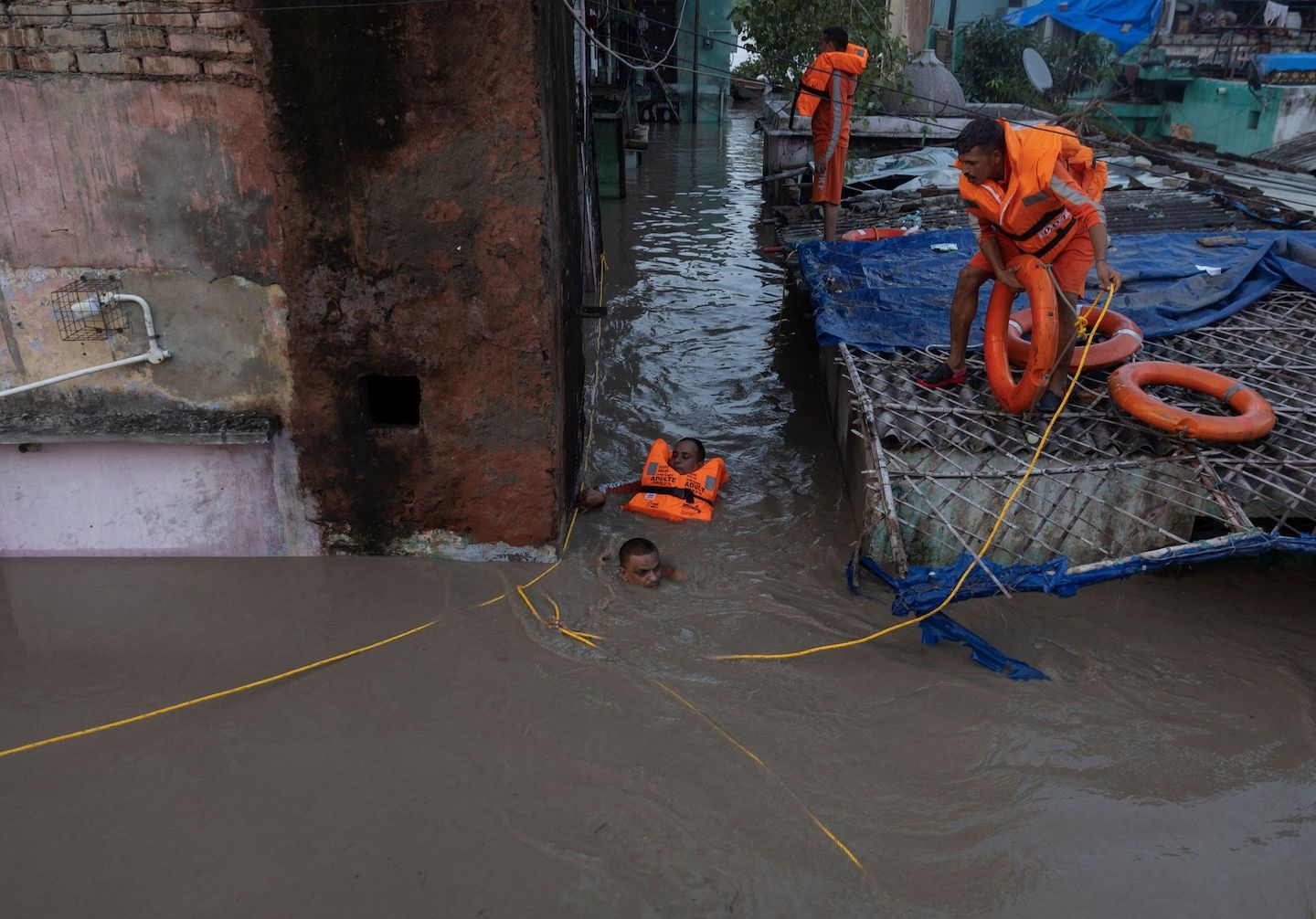Flooding, extreme heat waves, and hot oceans will continue
Listen 8 min Comment on this story Comment Gift Article Share
The world is hotter than it’s been in thousands of years, and it’s as if every alarm bell on Earth were ringing. The warnings are echoing through the drenched mountains of Vermont, where two months of rain just fell in only two days. India and Japan were deluged by extreme flooding.
They’re shrilling from the scorching streets of Texas, Florida, Spain and China, with a severe heat wave also building in Phoenix and the Southwest in coming days.
They’re burbling up from the oceans, where temperatures have surged to levels considered “beyond extreme.”
And they’re showing up in unprecedented, still-burning wildfires in Canada that have sent plumes of dangerous smoke into the United States.
Scientists say there is no question that this cacophony was caused by climate change — or that it will continue to intensify as the planet warms. Research shows that human greenhouse gas emissions, particularly from burning fossil fuels, have raised Earth’s temperature by about than 1.2 degrees Celsius (2.2 Fahrenheit) above preindustrial levels. Unless humanity radically transforms the way people travel, generate energy and produce food, the global average temperature is on track to increase by more than 3 degrees Celsius (5.4 Fahrenheit), according to the Intergovernmental Panel on Climate Change — unleashing catastrophes that will make this year’s disasters seem mild.
Advertisement
The only question, scientists say, is when the alarms will finally be loud enough to make people wake up.
“This is not the new normal,” said Friederike Otto, a climate scientist at the Imperial College London. “We don’t know what the new normal is. The new normal will be what it is once we do stop burning fossil fuels … and we’re nowhere near doing that.”
The arrival of summer in the Northern Hemisphere and the return of the El Niño weather pattern, which tends to raise global temperatures, are contributing to this season of simultaneous extremes, Otto said. But the fact that these phenomena are unfolding against a backdrop of human-caused climate change is making these disasters worse than ever before.
What might have been a balmy day without climate change is now a deadly heat wave, she said. What was once a typical summer thunderstorm is now the cause of a catastrophic flood.
Advertisement
And a day that is usually warm for the planet — July 4 — was this year the hottest ever recorded. Earth’s global average temperature of more than 17 degrees Celsius (62.6 Fahrenheit) may well have been the hottest it has gotten in the last 125,000 years.
Otto is the co-leader of the World Weather Attribution network — a coalition of scientists who conduct rapid analyses to determine how climate change influences extreme weather events. Since 2015, the group has identified dozens of heat waves, hurricanes, droughts and floods that were made more likely or more intense by human-caused warming. Several events, including the 2021 Pacific Northwest heat wave that killed more than 1,000 people, were found to be “virtually impossible” in a world untouched by human greenhouse gas emissions.
At this point, researchers say, the links between climate change and weather disasters are abundantly clear. When the planet’s average temperature is higher, heat waves can reach previously unheard of extremes. This was the case during recent heat waves in southeast Asia, southern Europe and North Africa, World Weather Attribution researchers found.
Advertisement
When temperatures soar past about 40 degrees Celsius (104 Fahrenheit), or when they are compounded by extreme humidity, it becomes more and more difficult for people’s bodies to keep cool through sweating. Kids and the elderly, as well as outdoor workers and people with preexisting medical conditions, are especially vulnerable.
This week, as more than 100 million people across the southern United States face exactly those conditions, climate researchers like Jennifer Francis fear the escalating heat may exact a deadly toll.
“We’re seeing temperatures exceed those that can support life,” said Francis, a senior scientist at the Woodwell Climate Research Center. “Certain places are becoming uninhabitable.”
“All of these records are being broken left and right, and my hope is people will start to put this together in their heads,” she continued. “These things shouldn’t be happening. It’s all connected to the fact that we’re warming the planet.”
The warmer the air, the more water it can hold — turning the atmosphere into a thirsty sponge that sucks moisture out of vegetation and soil. This exacerbates droughts and sets the stage for wildfires like those that have ravaged Canada this summer. Temperatures in the Northwest Territories spiked to 100 degrees over the weekend, intensifying fires that were already burning out of control.
Advertisement
The flip side of this phenomenon is that a warmer, wetter atmosphere also increases the amount of rain that can fall during a given storm. In Vermont and New York this week, about two months’ worth of precipitation fell in just two days — far more quickly than it could be absorbed by the region’s saturated ground and mountainous terrain.
The effects of extreme rainfall are even more disastrous in poorer countries, where people and governments have far fewer resources to cope. Rachel Bezner Kerr, a Cornell University sociologist who works with farming communities in Malawi, lost two close colleagues this spring when flash floods struck the north of the country.
Penjani Kanyimbo and Godfrey Mbizi drowned while conducting a surveys for a sustainable agriculture nonprofit, Soils, Food and Healthy Communities.
“It’s one of those bitter ironies,” Bezner Kerr said. “They were trying to work on a solution. … But these parts of the world that are contributing so little to the problem are facing many of the worst impacts.”
The severity of recent extremes on land has been matched only by the scorching conditions in the world’s oceans. Global average sea surface temperatures hit a record high this spring, and they remain nearly a degree Celsius (1.8 Fahrenheit) higher than the average for this part of summer.
Advertisement
“In a way it’s more concerning” than the record-hot atmosphere, said Ted Scambos, a polar researcher at the University of Colorado at Boulder. While the land — and the air above it — warm up and cool down fairly easily, the ocean conducts heat far more slowly.
“This means we’re storing a lot of heat in the ocean,” Scambos said. “The longer we wait [to act on climate change], the longer it’s going to take to have the ocean heat return to whatever normal is.”
In the Atlantic Ocean and the Gulf of Mexico, bathwater ocean temperatures will probably add fuel to this year’s hurricane season, making storms wetter and more intense.
And near the South Pole, where Scambos works, the record-hot oceans seem to have disrupted the current of cold water that typically surrounds Antarctica. This February, for the second year in a row, the extent of sea ice around the continent hit a record low. Now, even as Antarctica is immersed in the bitter cold of the months-long polar night, the ice has been distressingly slow to recover. That’s bad news for Antarctica’s glaciers, which need sea ice as a protective buffer from the jostling of ocean waves.
Advertisement
“This is unlike any behavior we’ve seen in the past in the Antarctic sea ice world,” Scambos said.
He tried to find words to express how it felt to watch the planet careen into such uncharted territory. “It’s ... ” he started. “Ahh ... ”
He shook his head. “This is more or less the picture that we’ve been describing for decades,” he said. “And for as long as we can stand it, we’re in for this kind of climate and worse, until we address the problem.”
The Intergovernmental Panel on Climate Change — which includes hundreds of the world’s top climate experts — has called for countries to roughly halve emissions by the end of the decade and eliminate planet-warming pollution by the middle of the century. Humans can unleash only about 500 more gigatons of carbon dioxide to have an even shot at keeping warming below a manageable threshold.
Advertisement
But global carbon dioxide emissions hit a record high last year, and governments continue to approve new fossil fuel projects that would make it almost impossible for the world to meet its climate goals, scientists said.
Bezner Kerr recalled her dismay at seeing President Biden approve the Willow Project — an Alaska oil development projected to generate 239 million metric tons of carbon dioxide over its 30-year lifetime — shortly after the deaths of her Malawian colleagues.
“It was really like, what will it take for people to see that we are creating an unlivable planet?” she said. “I felt there was not the political will in this country to face the reality of what was happening.”
Then smoke from Canada’s wildfires descended on her hometown of Ithaca, N.Y., staining the skies orange, and Bezner Kerr’s friends and colleagues started asking her for help processing their fear.
Maybe, she thought, this would be a turning point. Maybe people are finally realizing: The alarm bells are ringing for us.
Scott Dance contributed to this report.
Gift this article Gift Article
Source: The Washington Post


